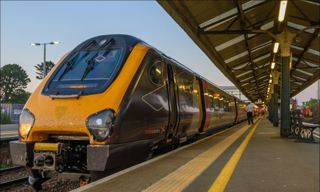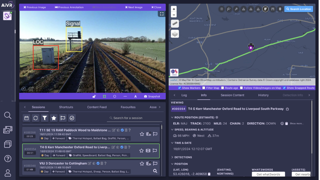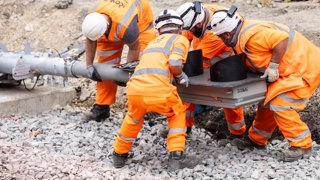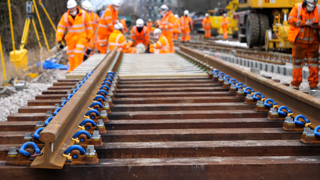The railway from Sheffield to Cleethorpes is one of those routes that seem to have been by-passed by the 20 years of investment and progress on our railways seen elsewhere.
Gainsborough, in particular, despite having two stations (Lea Road and Central), is suffering the gross indignities of underinvestment that would make even the penny pinchers of 1960s British Railways wince. This is an example of a railway that is anything but joined up. It’s disjointed, very poorly configured and (in numerous places) quite literally falling apart.
Through the early and mid-20th century, the line from Sheffield to Cleethorpes via Gainsborough was a main line. It allowed the working populations of the cities of Lincoln and Sheffield to reach the seaside at Cleethorpes, and boasted a major freight-carrying capability, supported by goods yards and facilities along the route.
The major station on the line is - or rather was - Gainsborough Central, which is a virtually derelict shadow of its former glory. The town has had a railway since 1849.
Today, Gainsborough seems at first glance to be nothing more than a medium-sized Lincolnshire town with perhaps fewer amenities than it deserves. Further investigation, however, illustrates some of the problems that the railways have faced for decades and which have yet to be solved here. All of these have been made worse by poor alignment of the privatised structure, leading to the shabby facilities endured by passengers today.
Gainsborough was once a major manufacturing centre in the East of England. It had the Marshalls works producing steam engines and tractors, which were exported globally. It even had a sweet wrapper factory that also made seaside rock! The town still has a population of more than 20,000 for its two railway stations, a nearby power station at West Burton and a sizeable steel working, industrial and manufacturing centre just outside the town.
Yet the service on the line through Gainsborough Central to Cleethorpes now numbers just three trains a week, operated on Saturdays-only since 1993. There are no weekday services on the Central line. Operator Northern Rail is clear that there are no plans to increase services. Worryingly, the Invitation To Tender (ITT) for the next franchise does not require an improvement of the Brigg line’s parlous service.
Northern Managing Director Alex Hynes made clear on local radio earlier this year that Northern was concentrating on its peak commuter services, not branch lines. He could give locals no hope that their stations and railway would be satisfactorily upgraded before the end of the current franchise.
However, the Friends of the Brigg and Lincoln Line (FoBLL), the local campaign group founded in 2012 and run with tremendous enthusiasm by Paul Johnson, is not willing to accept this. And it is fighting back.
The group campaigns tirelessly to improve stations and services on the route. Its main aims are currently to increase service frequency to Cleethorpes and to clean up and improve both woefully badly-maintained stations serving Gainsborough and its nearby towns and villages. Currently, it is these local, self-financed volunteers (not the TOCs) who are driving very limited improvements and getting most of the work done.
Gainsborough Central is managed by Northern and in 2014 was labelled Britain’s worst railway station by railway observer Andrew Dowd, writing in The Times. You can see why within minutes of arriving.
Until 1977, the station had a fine building (designed by Hadfield & Weightman of Sheffield, for the Manchester Sheffield & Lincolnshire Railway), an overall trainshed roof and a colonnaded porte cochère fronting onto the road that gave it a classic appearance matched by others on the line. There was also a considerable goods yard, locomotive shed and a fully staffed booking office with refreshment and waiting facilities.
But to go there now is to visit a sadly underused and under-funded derelict relic of immediate post-privatisation, post-industrial Britain. The platforms are weed-ridden, the boundary walls are crumbling, the fine Victorian lattice footbridge (the only surviving passenger infrastructure on the platforms) is peeling and deeply rusted, and even the platform destination signs were only installed this year - which is appalling, even for a station as little used as this.
The signs were finally installed after FoBLL brought to Northern’s attention that local volunteers had produced hand-drawn signage for the platform. The railway had provided absolutely nothing. There are no real-time train information boards, no announcement systems, and barely even a roof on the flimsy, metal-framed shelter. If you didn’t see it, you’d be reluctant to believe it.
But there is little use bemoaning the loss of our heritage railway buildings - they are long gone, along with the frequent weekday services once enjoyed by the station’s passengers.
What can be done - and is being done - in the face of appalling neglect by the privatised railway is activism to improve what little is left. FoBLL has been campaigning successfully for improved signage. The neighbouring (superb and busy) shopping centre will soon boast British Railways-style enamel signage for the station. And it is hoped that a meeting held on June 19 between locals, train operators and Network Rail will yield positive results. We shall report back!
Gainsborough Central’s lattice steel footbridge dates from the last quarter of the 19th century. It is in need of restoration, but is due to be replaced soon.
The plans currently proposed are for a like-for-like bridge replacement with no wheeled access ramps. The barrow crossing is to be closed, meaning that there will be no wheel-accessible route between platforms. But as the station is used (on Saturdays only) by many young families and elderly people for a seaside trip, FoBLL is currently opposing the plans. It reasonably believes that no wheeled access will choke off the 40% improvement in use that its hand-written signs and homespun activism has prompted over the past 18 months.
Operator Northern claims that Network Rail is in the process of improving the route: “Network Rail is undertaking a multi million-pound investment in the route at present. We have seen customer improvements at stations on this route as part of this investment, particularly in access changes at Metheringham, Ruskington and Saxilby.”
Nearby Saxilby (between Gainsborough Lea Road and Lincoln and managed by East Midlands Trains) has a new footbridge with ramps. A nearby barrow crossing was also replaced - essentially removing a facility such as that at Gainsborough Central, but still ensuring step-free access. The provision of uniform footbridges at Brigg and Gainsborough Central, or even the retention of the current footbridge and barrow crossing combinations, would greatly improve the situation at these stations. The railway needs to listen to FoBLL - it cares and talks a lot of sense.
The rest of the route has had improvements - the trouble is that these improvements are still unjustifiably below standard.
Compare Gainsborough Central station with the facilities at even the smallest station on London Underground (Roding Valley, which has indoor waiting facilities, a covered iron lattice footbridge, platform shelters and a ticket machine).
There is no step-free platform interchange at Roding, but there is access 520 metres away. At Gainsborough Central, the shortest route after the bridge replacement will be almost three quarters of a mile in length. Perhaps the restoration of a rare heritage asset (the existing bridge) and the retention of a crossing would be preferable to a damaging step backwards in accessibility and equality?
In 2008, the Brigg line was upgraded to enable an increase in freight traffic. This is mostly empties and coal traffic to and from Immingham Docks, essentially using the route as an avoiding line to bypass Scunthorpe.
Therein lies the rub. Because passenger trains only run along the entire length of the line on Saturdays, the signal boxes on the line are only staffed at weekends, making weekday working of the freight service between Immingham and West Burton power station impossible.
As a result, the trains are forced to divert south at Barnetby. In a mind-bogglingly daft piece of train planning, they then go through Lincoln, across the two notorious level crossings that divide the city, causing chaos. (On one of those crossings, there were two fatalities last year). This beggars belief, when they could so easily go via Brigg and ease the congestion at Lincoln.
Gainsborough Central station itself has very low passenger numbers - just 1,220 people in 2013-14, according to the Office of Rail and Road’s station usage estimates. It has three trains every Saturday to both Cleethorpes and Sheffield, but no weekday services. The campaign by FoBLL for increased services is ongoing, and is finally being boosted by local politicians.
The issue of a lack of services was even raised in Parliament, but Secretary of State for Transport Patrick McLoughlin chose instead to reiterate his determination to get rid of Pacers across the north of England, rather than make any assurances regarding service improvement. As the improvements sought by the FoBLL are not part of the next ITT on the route, it seems once again to be down to a local friends group to drive for any real improvements delivered. It’s hard to avoid the conclusion that the privatised railway has abandoned Gainsborough and remains indifferent to its shabby facilities and poor services.
A few miles to the north east, Brigg once enjoyed a similarly grand railway station to Gainsborough Central. However, it is now so little used (fewer than a thousand passengers in 2013-14) that it is unlikely to ever be staffed again. Incidentally, there are no ticket purchasing information or any other manned facilities at either Gainsborough Central or Brigg.
The station has undergone some minor improvements, with timetable boards and new signage installed by Northern over the past year. MD Alex Hynes even visited the station in March, after the FoBLL’s campaigns began to gain more publicity and momentum.
But in January, he had told BBC Radio Lincolnshire that there were no plans to improve the service on the line to Cleethorpes, because Northern’s focus is on busier peak commuter services.
There are plans lodged with North Lincolnshire Council for a footbridge at Brigg to replace the current one. The replacement has no ramps, and currently the barrow crossing is (like that at Gainsborough Central) the only disabled access to each platform.
Between Brigg and Gainsborough, the station at Kirton Lindsey is a rare survivor. The 1849 station building survives, but the track is singled.
There is no immediate plan for serious investment in the line’s stations, according to Hynes. He claims that such investment is “a bit chicken and egg”, and that the stations do not merit the sort of investment that Northern would earmark for larger stations such as those in Grimsby or Manchester.
His claim is reasonable from one point of view. Gainsborough Central, Brigg and Kirton Lindsey are not busy stations, nor are they likely to approach the passenger numbers of even the Conwy Valley or the Peterborough to Birmingham lines.
Nevertheless the stations are poorly maintained, particularly those at Gainsborough, which is jarring when neighbouring East Midlands Trains has acknowledged that its stations here are below standard and in need of improvement. (The pictures tell the story in embarrassing clarity.)
Gainsborough Lea Road is managed by EMT. It has an hourly weekday service to Lincoln, but currently no high-speed rail services, despite Virgin Trains East Coast HSTs passing through empty stock from Leeds to Lincoln daily on weekdays at 0614 and on the return at 2131. The Saturday service passes Lea Road at 0811 and returns on its Down journey at 2033.
FoBLL has been told that the empty coaching stock cannot stop at Lea Road because of a lack of catering staff, but VTEC refutes this, stating: “Our customer research suggests insufficient demand for a direct service from Gainsborough, using our empty coaching stock working from Leeds to Lincoln. The very early morning time at which this train passes through Gainsborough is a factor in this.” But would it really be so difficult and costly to stop an empty train that passes at reduced speed anyway?
Of Lea Road’s 19 weekday services, 14 are operated by Northern and the rest by EMT. The station is over 100 times busier than Central, with ORR estimates of 137,394 passengers a year in 2013-14.
Considering these figures, the station has received appalling treatment. Lea Road has had something of a bad run over the past few years - its building is partly vacant, many of its lights are smashed and not working, and its disabled access ramp is subsiding. On top of all that, the signal box burned down in 2009! Currently it has no indoor waiting facilities, station announcement equipment, or ticket buying machines available. All that remains of the gents toilet is the tiled floor, left when it was demolished.
Compare this with a similarly managed and serviced Lincolnshire station such as Stamford (also managed by EMT), a town with a comparable population. This station has all of the above amenities, as well as timetables, an emergency information system and its station building is in regular use as a popular transport bookshop. This kind of double standard is no longer acceptable on a 21st century railway and serves only to highlight the imbalance suffered across the country where the railway has disintegrated at the margins.
EMT says there are plans to improve Lea Road station, but that they are dependent upon Network Rail improving the trackwork first.
“East Midlands Trains always aims to make sure our station environments are welcoming, and we go to great lengths to try to ensure this,” says a spokesman.
“At Gainsborough, there are factors that have slowed down our progress as we have explored a number of options for making significant improvements to the station. However, there is work needed to be done by Network Rail first on the track infrastructure. After this, we can continue to work with our partners on making improvements.”
Ah yes, the track work! The track at Lea Road has already been upgraded to allow heavier freight (as at Central), but the major investment was the resignalling of Lea Road sidings... which have been disused for many years and which are unlikely ever again to see a train!
The rusty sidings have been disconnected from the junction point for years - but incredibly, this point has been renewed! And despite not being connected to the derelict sidings, it has full electronic signalling and point control equipment, telephones and LED signals.
The track is new, freshly ballasted and has the appearance of a line about to welcome the introduction of high-speed passenger services. There is even a crossover and signalling, all provided at fabulous cost and all of it unused. It will never be used. It is an unbelievable waste by Network Rail of around £250,000. Meanwhile, the station rots.
Thus, considering the dilapidated state of the station, it seems preferable that EMT’s planned improvement work be undertaken sooner rather than later. Why does EMT need to wait for infrastructure changes on a line that has already had huge investment in resignalling and trackwork upgrades?
“East Midlands Trains is certain that the current station fabric and environment is not what we want. However, there are plans to address platform access, platform quality and customer information and shelter provisions.”
This is at least recognition from the incumbent TOC that things need to improve. In the meantime, Lea Road has also had the benefit of community engagement at a number of levels.
Members of the Friends of Lea Road group are currently working on beautifying the station approach. The Friends have restored an original North Eastern Railway station approach sign, and are in the process of repairing the pergola-style roof of the Platform 1 access staircase. Flowerbeds and newly restored signage are also helping to restore some dignity to the site.
Some believe the station would reap greater rewards from a successfully established official Community Rail Partnership. Unfortunately, according to the Friends of the Brigg and Lincoln Line, Lincolnshire County Council has reacted negatively to the proposal.
The only backer was seemingly North Lincolnshire Council, with the Association of Community Rail Partnerships keen to continue with the establishment of a CRP if the backing, financial support and passenger numbers become sufficient to support one.
This may seem a strange reaction to what has proven to be a very successful programme of community involvement elsewhere, but it must be borne in mind that a CRP is reliant on a line being remunerative to begin with, in order to be really successful. The Association of Community Rail Partnerships (ACoRP) is unlikely to cause passenger numbers to increase without a catlayst in the form of improved services.
East Midlands Trains was not willing to comment further on how the neglect at Gainsborough Lea Road has been allowed to reach its current levels.
- This feature was published in RAIL 777 on June 24 2015.















chris - 16/11/2015 12:47
Great article about time network rail are shown for what they really are -notwork rail Gainsborough central is a disgrace